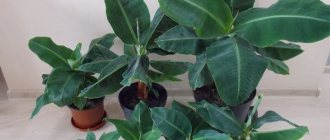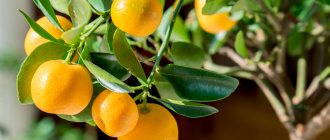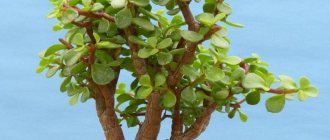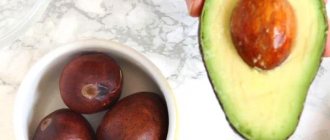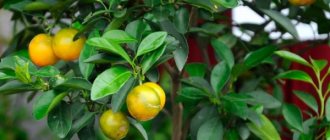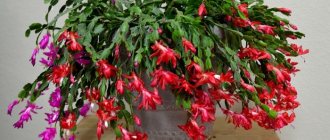A spectacular indoor banana will bring a little exoticism into the room. This plant with luxurious leaves needs plenty of space. Bananas have been cultivated by people for hundreds of years. The fruits of this plant are eaten, in addition, it is a magnificent decorative species. In nature, bananas are found in the tropics of Africa, India, and Asia.
This genus includes about 40 species of rhizomatous plants that produce lateral shoots. Bananas are grown in all tropical regions of the globe, including the Australian state of Queensland. This is an evergreen plant. The “stem” of a banana consists of overlapping leaf stalks. Dwarf banana varieties and species prefer lower air temperatures than plantation-cultivated varieties.
In a large flower pot or tub, a banana can reach 1.8-2.4 meters in height. It does not matter where you are going to grow bananas: in the house, in a greenhouse or in a greenhouse, in any case, choose a dwarf variety. Large elongated leaves reach 30-45 cm in width and 90-120 cm in length. They are very delicate, so holes quickly appear in them.
If the homemade banana is in a windy place, then the leaves of the plant will be torn, since the leaf blade is very tender, and the wind tears it. Therefore, if there are whole leaves on a banana growing in the wind, it is a miracle.
If you find that the leaves of the plant are rotting, then your banana is in a room with too low an air temperature; if the plant does not produce new growth, then the banana does not have enough nutrients. In this case, the plant must be replanted or fed.
We choose plants of a known variety. There should be no spots on the leaves.
Banana needs warmth, good light and high humidity. If you want it to bloom and bear fruit, then provide the plant with as much space as possible on a heated veranda or glassed-in terrace.
How to care
- The soil. We plant bananas in permeable soil based on peat.
- Landing. In large pots or containers, be sure to lay a layer of drainage at the bottom; you can add perlite or vermiculite to the soil.
- Transfer. We replant bananas in the spring every two years. In large tubs or flowerpots, it is enough to change the top layer of soil.
What is the best variety of banana plant to grow at home?
When you are deciding what type of banana plant you want to grow indoors, you should know that not all varieties produce fruit.
Also, remember that full-size banana plants can grow quite large, so I always recommend a dwarf variety for indoor growing.
Different varieties of bananas have different tastes. So you may want to research this before deciding which variety to grow.
The most popular banana variety for growing indoors is the Super Dwarf Cavendish variety, as it only grows to 1.2 meters.
Other varieties suitable for growing indoors are "dwarf Cavendish" (2.7 meters), "dwarf Lady Finger" (2.7 meters), "Gran Nain" (2.4 meters), "dwarf Brazilian" ( 4.6 meters), “dwarf Jamaican” (2.4 meters), “Williams hybrid” (2.4 meters) and “Rajapuri” (3 meters).
Where to put
— Lighting . All types of banana do best in moist and warm places, illuminated by bright sun.
- Temperature . In summer, these plants feel good indoors at room temperature, in winter at a temperature of 15 degrees.
- Humidity . To increase the humidity in the room, place the pot on a stand filled with water with pebbles or frequently spray the leaves of the plant with water.
Banana at home:
Summer: During this period, the plant can be taken outside or onto the balcony.
- Street. The pot with the plant can be buried in the garden, which will prevent the soil from drying out too quickly. In order to protect the roots of the plant from pests, you need to put a nylon stocking on the pot. When growing a banana in the garden, the main thing is to bring it indoors in time, since by autumn the nights become cooler, and a drop in temperature can have a bad effect on the plant.
- Balcony. Balcony windows should have curtains to protect the plant from direct sunlight.
Winter: Watering must be reduced. During this period, it is necessary to monitor it more closely, since even one mistake can lead to rotting of the entire root system of the plant. Banana is very afraid of sudden drops and changes in temperature; it must be protected from cold and drafts. Provide sufficient humidity, especially if the pot is placed close to operating heating devices.
How to propagate
- Reproduction. In the spring, bananas can be propagated at home by division. Side shoots grow from the root ball of the plant, which can be separated from the mother plant and planted in a separate container.
- - using a sharp knife, separate the side shoot with roots from the mother plant. We carry out the procedure carefully.
- - replant the mother plant in permeable soil, remove dead fragments of the root ball.
- - Place the cut side shoot in a suitable container and plant it in the same soil as the mother plant. The roots should be just below the surface of the soil. We crush the soil in the pot, water it and place the container with the planted shoot in a warm and humid place.
- - We provide the banana with regular watering, making sure that the soil remains moist all the time until the plant takes root.
More about the flower
The indoor banana has a very developed underground part, consisting of a powerful spherical rhizome, on which there is a central growth point. The shoot of the plant is very short and is located underground. Therefore, there is no need to make the mistake of many inexperienced gardeners and confuse large ground leaves with shoots.
Banana is a houseplant that boasts large, long-petioled leaves. They wrap around each other's bases, which is why they look like shoots. The leaf blades can grow up to 3 m in length and up to 0.5 m in width. They have an ellipsoidal shape and a green color. Immediately after fruiting, the leaves of indoor bananas die off and new ones grow in their place.
Indoor banana flower: the plant blooms for the first time about a year after planting. During this time, the banana develops 15-16 leaves, and it can already be called an adult. Banana flowers can be pale yellow or green. Flowering duration is 2-3 months.
Pests and diseases
— Pests White dots on the underside of banana leaves are a sign of damage to the plant by feltworms. If there are few pests, we remove them manually, otherwise we use an insecticide.
— Diseases If brown spots appear in the center of the leaf and the edges of the leaves turn brown, then the soil in the flower pot is too dry and the air humidity is very low. Water the plant more abundantly. During active growth of the banana, we provide regular, abundant watering; the leaves are often sprayed with water. Torn banana leaves (sometimes the tear extends to the midrib) are normal. Surely such damage was not caused by diseases or pests. If this phenomenon occurs, it means your plant is in a windy place or has been poorly cared for. Immediately move the banana to a place protected from strong winds.
What to do after buying a plant
In the store you need to choose a small, young plant. It has the best adaptive abilities. Adult specimens have difficulty taking root in new conditions. When transporting from the store, the seedling does not require special conditions if it is warm outside. A store-bought package will be enough for him.
careful insulation is required . The plant does not tolerate cold. The pot needs to be wrapped in several layers of paper, wrapped with padding polyester or other insulation on top, and placed in a tight box.
The houses of the new “tenant” are isolated for 12-14 days from other indoor plants. During this time, the tropical guest adapts to the new place. The seedling is periodically inspected to identify possible diseases or the presence of pests. After quarantine, the young banana must be transplanted into a new pot with nutritious soil and good drainage. The pot should not be too bulky. It is enough to take 2-3 cm more than store bought.
Flower design
When choosing a plant, or rather a variety or type of banana, you need to understand where you will grow it. Several types of banana can be grown on a veranda or on a glassed-in terrace: these include: velvety banana, reaching 1.2 m in height, leaves 60 cm long, yellow flowers with red stipules, inedible fruits, as well as a dwarf species reaching 1.2 m in height, which is usually propagated by shoots and the bright red banana is only 90cm high. This tropical plant will bring into your interior like other tropical palms. Good luck to you.
Banana blossom:
Can last all year round. The flowering period begins with the awakening of a flower bud in the center of the rosette, which grows in height through all the leaves and forms a large flower, which can reach 150 cm in size. Flowering is long, the flowers are bisexual, heterosexual, but the ovary occurs only in female flowers. In the wild, pollination occurs with the help of bats or birds; at home, pollination occurs with the help of humans.
After pollination, fruits are formed that form a bunch. There can be from 200 to 500 fruits in such a bath. The upper fruits begin to ripen first, but the lower ones may still be green. A banana begins to bloom when 15-18 large leaves are formed. A bud, red-violet or violet-pink, appears from a rosette of leaves, which, as it blooms, sinks lower and lower to the soil. Banana blooms for quite a long time, the period varies from 3 months to 1 year. The fruits begin to ripen from top to bottom, so the lower ones ripen last. The taste of bananas is different from store-bought ones, as they ripen right on the plant. Imported bananas are picked green, unripe, and ripen during transportation directly in containers.
Recipes
To prepare pawpaw for cooking, wash it, peel the skin and remove the seeds. This is done just before the start of cooking so that the pulp does not start to deteriorate.
Cookie
To bake the dessert, you will need: a glass of wheat or flaxseed flour, 100 g of granulated sugar, 75 g of butter, one chicken egg, walnut kernels (can be replaced with peanuts), one pow-pow. The pulp is blended or mashed with a fork if the berry is very ripe. Grind the softened butter with sugar and mix with flour. Half of the nuts are poured there. Add berry puree to the mixture and beat in an egg. The mass is brought to a homogeneous state. The dough is placed on baking paper in small portions. The top of the dessert is decorated with the remaining nuts. Cookies should be baked at 160 degrees until brown.
Ice cream
Take one fruit of a banana tree and put it in a blender. A liter of high-fat cream is mixed with six eggs, and a glass of sugar is poured into it. The mixture is placed on the stove and brought to a boil, but there is no need to boil it. Cook the mixture over low heat until thickened. After this, the mass is cooled and placed in the refrigerator. Add the juice of half a lemon and a teaspoon of vanilla sugar to the pau-pau puree. This mass should be mixed with cooled cream and placed into molds. Place the ice cream in the freezer until it hardens.
Smoothie
To obtain a tasty drink, take the prepared pulp of one fruit of a banana tree, 5-6 large strawberries, pieces of papaya, and peach. The ingredients are mixed in a blender with the addition of a small amount of granulated sugar and milk. The finished drink can be decorated with mint leaves.
Beneficial features
Paw paw berry is very nutritious as it contains many beneficial microelements. It contains:
- B vitamins (thiamine, riboflavin, niacin), ascorbic acid, retinol.
- Potassium, magnesium, calcium, copper, phosphorus, zinc.
- Amino acids (tryptophan, arginine, lysine).
- Fructose.
- Plant flavonoids.
Paw paw seeds contain substances that kill cancer cells. Residents of the Indonesian islands who eat the fruit do not have this disease. The medicinal benefits of the fruit have been proven by research by American doctors. Pawpaw leaves and bark have immunomodulatory properties. They are dried, crushed, and then used to prepare medicinal decoctions. Regular intake of such compounds helps to resist viral diseases and protects against colds during seasonal epidemics.
A large amount of retinol strengthens eye cells and restores vision. Pawpaw contains a high concentration of vitamin C. Our body needs it for the formation of healthy blood and good intercellular metabolism. It is an antioxidant that slows down aging. Thanks to this element, the body is filled with energy, fatigue goes away, and well-being improves. The high content of minerals has a positive effect on the state of the nervous system. When consuming northern banana, brain performance increases, memory and coordination are strengthened.
Other useful qualities of pawpaw:
- normalizes the amount of bad cholesterol, reducing the symptoms of diabetes;
- regulates blood pressure;
- enhances the regenerative abilities of cells. The pulp and juice of pau-pau leaves heals wounds on the surface of the skin and mucous membranes;
- increases the reproductive functions of the body. Increases libido in men, promotes the process of conception;
- reduces the risk of heart disease and vascular damage.
Eating the pulp and decoctions of tree bark cleanses the body of parasites. Native Americans knew about this property and used parts of the plant as an anthelmintic. An infusion of seeds is used to treat food poisoning. It is an effective emetic that removes toxins from the body.



